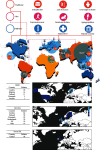The Impact of Diabetes on Vascular Disease: Progress from the Perspective of Epidemics and Treatments
- PMID: 35434140
- PMCID: PMC9012631
- DOI: 10.1155/2022/1531289
The Impact of Diabetes on Vascular Disease: Progress from the Perspective of Epidemics and Treatments
Abstract
At present, the global incidence of diabetes has increased in countries with large populations, and the changes in developing regions are particularly worthy of attention. In the past 40 years or so, the income situation in China, India, and other countries has exploded, leading to changes in the way of life and work as well as an increase in the prevalence of diabetes. Metabolic disorders caused by diabetes can lead to secondary vascular complications, which have long-term malignant effects on the heart, kidneys, brain, and other vital organs of patients. Adequate primary prevention measures are needed to reduce the incidence of diabetic vascular complications, and more attention should be given to treatment after the disease. To this end, it is necessary to determine a standardized drug and physical therapy system and to build a more efficient and low-cost chronic disease management system.
Copyright © 2022 Runyang Liu et al.
Conflict of interest statement
The authors declare that there is no duality of interest associated with this manuscript.
Figures


References
-
- Saeedi P., Petersohn I., Salpea P., et al. Global and regional diabetes prevalence estimates for 2019 and projections for 2030 and 2045: Results from the International Diabetes Federation Diabetes Atlas, 9 edition. Diabetes Research and Clinical Practice . 2019;157:p. 107843. doi: 10.1016/j.diabres.2019.107843. - DOI - PubMed
Publication types
MeSH terms
LinkOut - more resources
Full Text Sources
Medical
Miscellaneous

